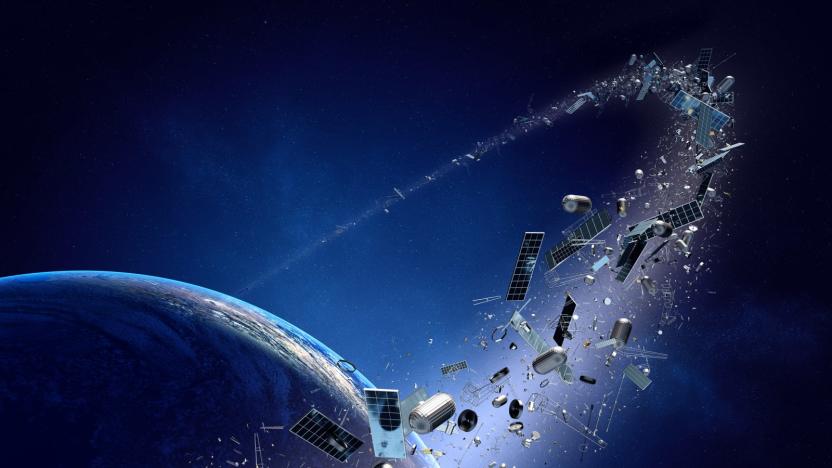spacejunk
Latest

Chinese scientists unveil plan to zap space junk with orbital lasers
There have been more than a few proposals for eliminating space junk, such as grabbing it, gobbling it and blasting it from Earth. The latest idea, however, may be the most dramatic... and the most effective. Chinese researchers have successfully simulated an orbital laser station that would zap small debris (under 4 inches long). The system would zap targets with 20 bursts of light per second for 2 minutes, either deflecting the junk out of harm's way or sending it to a fiery end in the atmosphere.

A lizard-inspired robot gripper may solve our space-junk problems
Space junk is a huge problem in orbit. Over 500,000 pieces of debris are currently orbiting the Earth at up to 17,500 miles per hour, and we haven't yet figured out how to clean it up. But engineers at Stanford may have made a breakthrough: They've designed a robotic gripper based on gecko's feet that works in zero-g. The end goal is to use it to clean up space junk.

ICYMI: Orbital space junk is putting us in jeopardy
try{document.getElementById("aol-cms-player-1").style.display="none";}catch(e){}Today on In Case You Missed It: The US Air Force is moving its Space Surveillance Telescope to Australia to track space junk littering geosynchronous orbit. That's the orbit 22,000 miles away from our planet where satellites mirror the Earth's rotation so that they don't appear to move. The Department of Justice story about facial recognition is here, while that darling sneezing baby (who eschews costumes) is here. If you enjoy the cartoon humor that is an engine giving up on a job, that's here. As always, please share any interesting tech or science videos you find by using the #ICYMI hashtag on Twitter for @mskerryd.

ICYMI: A space-based full service stop, bat drone and more
#fivemin-widget-blogsmith-image-426380{display:none;} .cke_show_borders #fivemin-widget-blogsmith-image-426380, #postcontentcontainer #fivemin-widget-blogsmith-image-426380{width:570px;display:block;} try{document.getElementById("fivemin-widget-blogsmith-image-426380").style.display="none";}catch(e){} Today on In Case You Missed It: DARPA's own AAA satellite service to service satellites orbiting Earth could launch in about five years, if all the testing goes as planned. A new drone is based on the form of a bat and the resemblance is uncanny. And Google is helping robotic graspers learn hand-eye coordination by giving them new objects to pick up. If you've followed along with some of the 3D-printed prosthetics we've done stories on, you'll want to see this glitter shooting, darling girl. And as always, please share any great tech or science videos you find by using the #ICYMI hashtag on Twitter for @mskerryd.

Watch 58 years of space debris appear in 1 minute
You probably know that the proliferation of space junk is a real problem, but we won't blame you if you have a tough time wrapping your head around the concept. There are roughly 20,000 fragments up there, after all. However, university lecturer Stuart Grey is willing to help. He recently posted a 1-minute video that shows the accumulation of junk from 1957, when Sputnik first flew, through to 2015. As the clip shows, the amount of debris grows in fits and starts. While there were several thousand objects for quite a while, missile tests and satellite collisions added thousands more fragments to the mix.

Scientists built a spacecraft that converts junk to fuel
It turns out that the sky is full of space debris, which poses a threat to craft and satellites orbiting Earth. A team of scientists at Tsinghua University in Beijing, China have come up with a way to remedy this. They've developed a spacecraft that collects the debris in a wide-cast net and uses it as fuel to propel itself forward. This technically means it could keep cleaning forever, unless an unforeseen event brings its efforts to an untimely end. Lasers have been developed for eliminating larger pieces of space junk, however aren't designed for smaller bits that are harder to locate and track. That's where Lei Lan and her team come into the picture.

Russia's next space station trip will take days, not hours
It's not a great time to be a Russian cosmonaut. Thanks to the International Space Station making a maneuver to avoid space junk, the next Soyuz spacecraft's flight (due September 2nd) will take two days to reach the station instead of the relatively brisk six hours of recent trips. That's more than a little unpleasant if you're stuck in a cramped capsule, and negates a lot of the planning work that has saved so much time from 2013 onward. There's no indication as to when (or if) launches will speed up, so crews may have little choice but to tough it out in the near future. [Image credit: NASA, Flickr]

Lockheed Martin to track space junk from the Australian Outback
In the movie Gravity, masses upon masses of floating debris hurtled through space at alarming speeds and collided with the heroine's space shuttle, killing her crew. Space junk isn't just something made up for the movies, though -- it's a real issue that's costing space agencies a whole lotta money. As such, Lockheed Martin has teamed up with Australian company Electro Optic Systems to build a space object tracking facility in western Australia, which the latter has been planning for years. While the U.S. Air Force's debris-tracking Space Fence (also developed by Lockheed Martin) uses radar systems, this one will use an optical technology like those found in telescopes to zoom in on objects, and lasers to calculate their speed and distance from Earth.

Air Force might shutter satellite- and space junk-tracking Space Fence soon
We imagine the Air Force is none too pleased that Space Fence might shutter as soon as September 1st due to budget constraints, according to leaked memos obtained by Space News. Space Fence, a powerful system of radars that track satellites and space junk orbiting the Earth, performs 40 percent of the Air Force Space Surveillance Network's observations. It can detect objects as small as a basketball up to 24,000 kilometers away and can constantly beam info back to the planet with no human input. It's no surprise then that the airmen called it a "critical defense system" when they tried to save the project in July -- an endeavor they failed if this info turns out to be true. Before anyone worries about unmonitored celestial debris hurtling toward Earth, know that a plan to build a more advanced Space Fence replacement exists. The only reason why it's not in the works is because it has yet to secure funding, leading this editor to think that someone really needs to get started engineering a money tree. [Image credit: NASA]

Murchison Widefield Array goes live, will study the sun, space junk, the early universe and more
We hope IBM's hardware is ready to chew through the feast of data it's going to receive, as the Murchison Widefield Array (MWA) radio telescope is officially open for business science. Located in the outback on the same site as the Australia SKA Pathfinder, it's one of three "precursor" programs that'll help steer future development of the extra powerful Square Kilometer Array. The MWA low-frequency telescope has plenty of work to be getting on with, and some of its first tasks include gazing into the sun to observe solar flares, storms and other activity, as well as scanning the Milky Way for the likes of "black holes and exploding stars." It'll also look into the tracking of hazardous space garbage using FM radio waves that are lost to the void, and explore the early life of the universe as far back as 13 billion years. According to Curtin University's Professor Tingay, the MWA's commendable work ethic (read: data quality) means we could see initial results from some of these projects "in as little as three months' time."

UK engineers developing harpoon that could help space junk meet a fiery end
Sure, we can pull space junk out of orbit with lasers or use it to cobble together new satellites, but if engineers at space firm Astrium UK have their way, space trash could be disposed of with the help of harpoons. Currently in a conceptual stage, the system is designed to shoot defunct satellites or other debris with a harpoon mounted on a "chaser satellite" and use a tethered propulsion pack to send the rubbish in an atmospheric descent where it'll burn up. Since the projectile could shoot straight through targets and result in even more garbage, it's been fashioned with a crushable portion to reduce its speed upon impact. There's no concrete word on when the outfit's solution might be put in action, but they'll present their work on Wednesday at the 63rd International Astronautical Congress in Naples (Italy, not Florida, mind you). If you can't wait to see the harpoon at work, head past the break to catch tests of an Earth-based prototype.

Pentagon starts Phoenix trial to harvest defunct satellites, MacGyver new ones from orbit
The Phoenix Frankenprogram to harvest the corpses of expired satellites and cobble together new ones seemed like one of DARPA's more daft ideas, but this one has actually kicked off its first phase of development. The plan is to first launch a service craft -- replete with robotic arms and enough processing horsepower to work independently if needed -- followed by the tiny base-unit skeleton satlets. The service mothership would dip into an orbital area called the "graveyard", grabbing pre-chosen cadavers and picking off usable parts, especially valuable antenna arrays, with its robo-limbs. Those parts would be jury-rigged to the bare-bones units, creating usable Pentagon satellites and saving the $10,000 per pound launch cost. So far, a $2.5 million contract to develop the needed technology has been put in place, and bids for the no-frills satlets went out last week. Plenty of dirty work is still needed, so check the video after the break to see if the overly-elaborate plan can un-moot $300 billion of orbiting cold metal.

DARPA's Dr. Frankenllite could plunder space graves, create orbital abominations (video)
There are countless satellites, long deactivated, orbiting the Earth in what amounts to a giant cemetery in the sky. DARPA's Phoenix program sees these piles of junk not as refuse, but as a resource just waiting to be harvested. The plan is to re-engineer existing technology, like robots used in remote surgery and advanced imaging systems found in off-shore drilling platforms, for the harsh environment of space. The resulting orbiter would operate on the deceased (with the owners approval, of course), salvaging what it could and stitching them together to create new functional satellites. (Try storming those gates angry mob!) DARPA is also looking into building tiny "satlets" which could simply be clipped to the antennas of deactivated satellites, breathing new life into them and saving a significant chunk of cash. Head on after the break for a video of what the orbiting, robotic Dr. Frankenstein might look like as well as some PR.

In lasers we trust: NASA researches 5kW galactic trash disposal system
Space junk is a growing problem -- 200,000 pieces and counting -- and as the amount of earth's orbital debris increases, so does the chance some satellite will be involved in a cosmic collision. As this would cause much gnashing of teeth and woe for the affected terrestrial parties, some researchers from NASA's Ames Research Center have pitched the idea of moving said junk with a laser -- once again proving that everything's better with lasers. The idea is to use a 5kW ray, likely similar to the one we've got at the Starfire Optical Range, to slow our galactic garbage -- perhaps slowing it down enough to burn it up in earth's atmosphere. Current estimates say such a laser could migrate ten pieces of junk a day, which gives us the promise of a future with neat and tidy skies.

Australians develop space junk laser tracking system, still can't track space jams
Australian company Electric Optic Systems has announced its developed a laser tracking system which will be able to stop space junk -- discarded debris in orbit around the earth, of which there is currently over 200,000 pieces larger than 1cm -- from colliding with satellites and spacecraft. The new laser system is more precise than previous radars specifically because of its ability to track debris that is small, which can still cause major problems if encountered. Using a 3.5 million dollar grant from the Australian government, the company developed the system which it says will ultimately work best as a network.

'Refrigerator-sized' device to be heaved into space
If you thought hoisting a giant banana above Texas was outrageous, you may indeed chuckle to learn that a 1,400-pound refrigerator-sized container of ammonia will be jettisoned from the International Space Station next week. On July 23rd, to be precise, Expedition 15 crew member Clayton Anderson will have the, um, privilege of heading outside in order to toss "two large hunks of unneeded equipment towards Earth," and once ejected, they will be tracked by NASA for an entire year until they finally begin to enter the atmosphere. Notably, officials are still not sure where the debris will land just yet, but if you happen to find your fridge replaced with a partially disintegrated (albeit similarly sized) container of fetid material in the next year or two, you'll know exactly what went awry.[Image courtesy of MSNBC]










